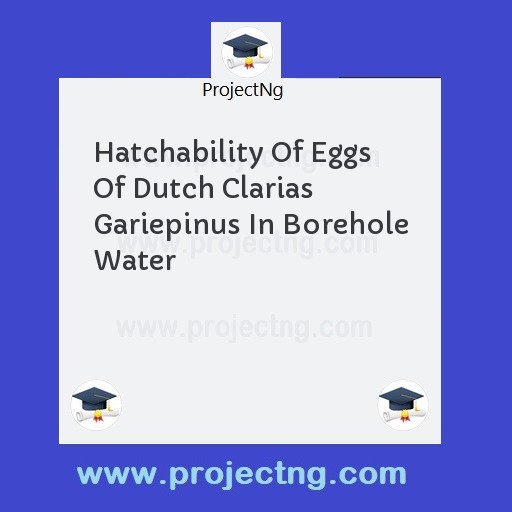Hatchability Of Eggs Of Dutch Clarias Gariepinus In Borehole Water
Science Lab Technology Project Topics
Get the Complete Project Materials Now! »
HATCHABILITY OF EGGS OF DUTCH Clarias gariepinus IN BOREHOLE WATER
ABSTRACT
The effects of spawning with water from bore-hole without treatment and treatment on egg hatching of Dutch Clarias gariepinus was studied. Broad stock of males and females of Dutch Clarias gariepinus were transported from reputable fresh farms from wari and Ibadan respectively. The broad stock was acclimated for two weeks and female was injected with ovaprim at in 500galons for 10 hours. Eggs stripped from the females and fertilize with milt collected by cutting open the testes of the makes. The fertilized eggs were spread on Kakabans made of bag materials. The spread eggs were stood in labeled containers and monitored for hatching pH, temperature and dissolved oxygen were determined. Colour changes of eggs were observed hatching was observed in the ponds at 22nd hour and 25 percentage. Untreated water from bore-hole had better hatching than the treated water bore-hole. The untreated water from bore-hole can be recommended for hatching of eggs in artificial breading of Dutch Clarias gariepinus
TABLE OF CONTENTS
Title Page i
Certification ii
Dedication iii
Acknowledgement iv
Abstract v
Table of contents vi
CHAPTER ONE
Introduction 1
CHAPTER TWO
2.0 Literature Review 6
2.1 Requirements for fish hatchery 7
2.2 Hatching construction 11
2.3 Fish seed hatchery 13
2.4 Brood stock management 14
2.5 Spawning methods 16
2.6 Hormone in fish spawning 17
2.7 Hatching management 18
2.8 Nursery management 20
CHAPTER THREE
Material and methods 22
3.0 Study are: 22
3.1 Construction of fish hatchery 22
3.2 Transportation of broad stock 23
3.3 Preparation of hatching troughs 23
3.4 Preparation of kakabans 23
3.5 Harvesting and weighing of brood stock 24
3.6 Identification of sex brood stock 24
3.7 Injection of hormones 24
3.8 Procurement of milt 25
3.9 Stripping of egg 25
3.10 Fertilization of eggs 25
3.11 Spreading of fertilized eggs on kakaban’s 26
3.12 Determination of temperature 26
3.13 Determination of ph 26
3.14 Determination of dissolved oxygen 27
3.15 Observation of colour changes 27
CHAPTER FOUR
4.1 Results 28
4.2 Hatching of eggs 38
CHAPTER FIVE
5.0 Summary and Discussion 39
5.1 Conclusion 40
5.2 Recommendation 40
References 41
CHAPTER ONE
INTRODUCTION
The hatchability of Dutch Clarias gariepinus. The successful large-scale cultivation of any organism for human consumption demands that the resources be easily renewable (Harvey and Hoar, 1979) it is clearly of no use of cultivate any organism when the supply of the young cannot be easily replenished. Among the numerous species of fish under cultivation in Nigeria notabily are common carp, cat fish (Clarias gariepinus) heterobranchus spand Tilapia sp.
The culture potential of Clarias gariepinus and Heterobranchus have been discussed by a number of authors among are Micha (1973) Legendre (1986) etc. The steadily growing importance of fishery product has compelled, improvements in the technologies necessary to boosting its production. Aquaculture production of Clarias gariepinus has been practiced for a long time in Africa. Increased productivity of fry and fingerlings with attributes of faster growth rates and better environmental tolerance is vital to ensuring fish food security in Africa. Fish culture today is hardly possible without the artificial propagation of fish seeds of preferred cultivable fish species. The need for the production of quality fish seed for stocking the fish ponds and natural water bodies has increase steadily.
Artificial propagation methods constitute the major practical means of providing enough quality seed for rearing in a confined fish enclosure waters such as fish ponds, reservoir and lakes (Charo and Oirere, 2000).
Apart from being able to obtain quality seed, the artificial breeding techniques can also be used to develop fishes superior to their ancestors by the methods of selective breeding and hybridization. The artificial breeding technique can achieve some times 65% or more of the eggs been raise to viable fingerlings compare to less than 1% survival rake on natural spawning. The issue in this artificial breeding is how to increase the productivity or the hatchability of eggs through quality or conducive water, pH and temperature management. The concept that every recipient water body has capacity to assimilate contaminants has been the basis for establishment of quality critical for aquatic life by different and national organization.
In other to ensure increased production of fry, (larva) and viable fingerlings. It is pertinent to evaluate factors that influences the hatchability of eggs.
These factors include:
Temperature: Temperature is an important factor that affects the ability of eggs to be hatched. Temperature according to graham S, H, and Mohammed F.A (1995) the major abiotic factor controlling the rate of morphogenesis in fish. According to these authors the hatching is possible between temperature range of 150C to 350C. They however noted that the hatchability improved around 300C.
Onyeleye (2006) also noted that at average temperature at 27.66%, hatchability is about 27.84% .
pH: pH is an important factors that affect the ability of eggs to be hatched, best pH for maximum hatching is 7.5 to 8.5. According to Ariole C.N. and Okpokwesili G.C. (2012) noted that average pH of 7.5 to 8.5 form best in hatchability of Dutch Clarias gariepinus.
Oxygen: Maximum productivity require adequate supply of oxygen. The oxygen dissolved in water must be enough to ensure high productivity and the viability of the fingerlings.
Light: Fishes are photophobic, therefore, they are sensitive to lights especially artificial light.
Water quality: This factor is the major thrust of this study. The quality viability of eggs.
The aim of this study is to determine the use future as of bore-hole water. In the hatchery of Clarias gariepinus.
Be the First to Share On Social

Enjoying our content?
Don't miss out on new videos! Subscribe to our YouTube channel for more awesome content.
Subscribe Now!













